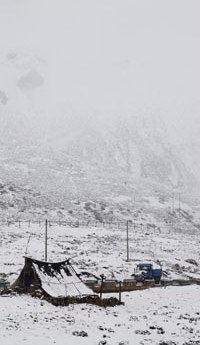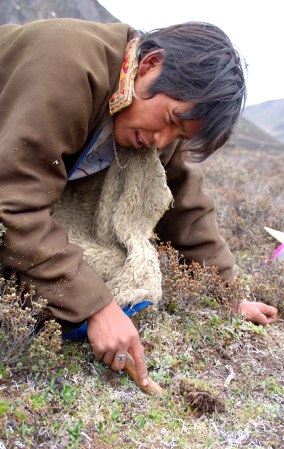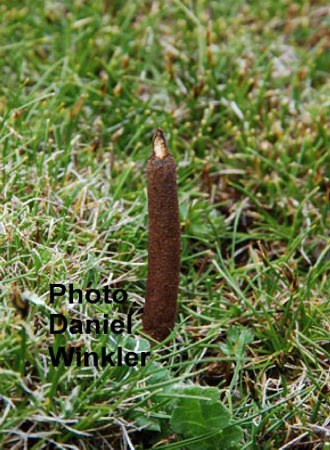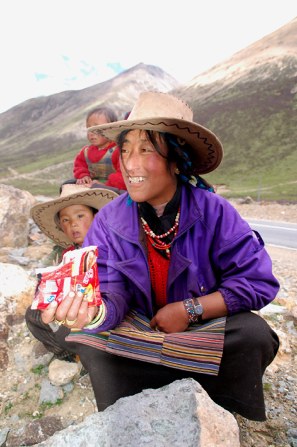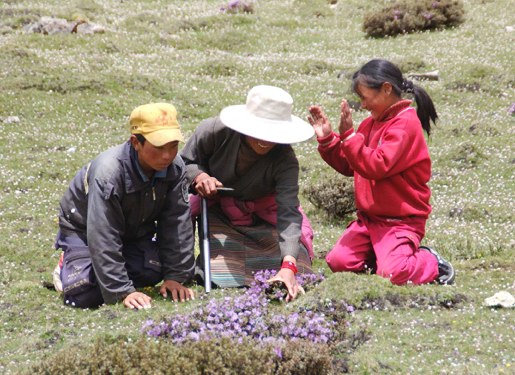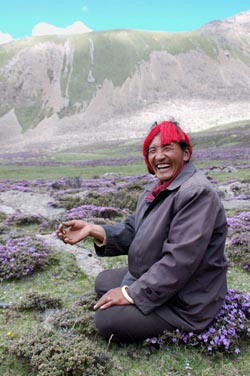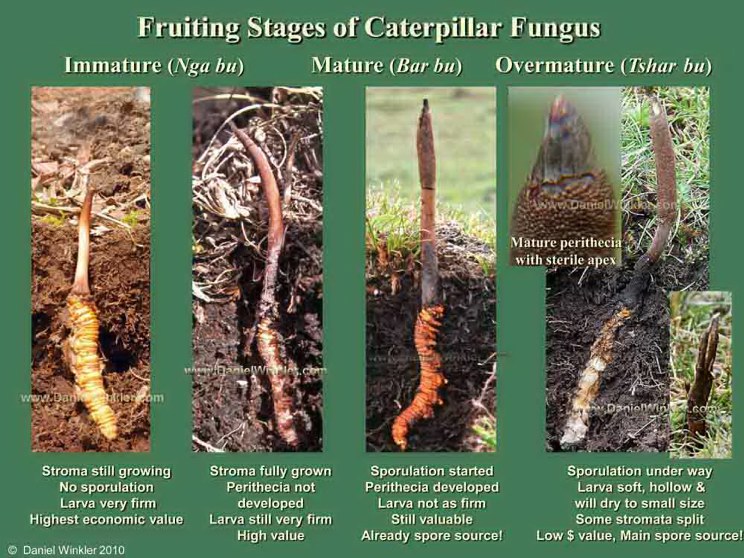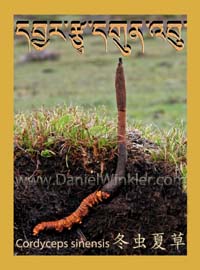དབྱར་རྩྭ་དགུན་འབུ་ Ophiocordyceps sinensis 冬虫夏草 Yartsa Gunbu Caterpillar Fungus Dong Chong Xia cao |
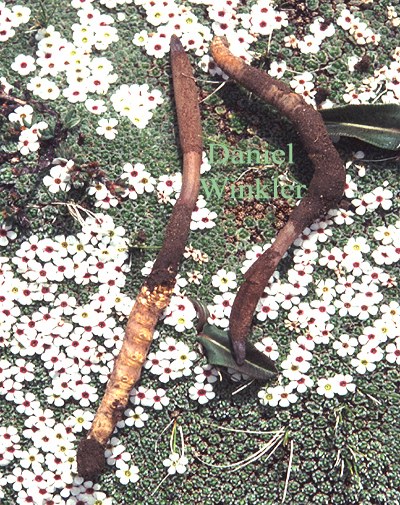 |  If you would like to use any of my photos please contact me. | |||||||||
The stroma (= sporocarp = fruiting body) of the fungus grows above ground in spring or early summer to facilitate spore dispersal. The stroma grows out of the head of the former caterpillar (technically a larva), which otherwise would overwinter buried deep in grass or other perennial roots. The larva, if not taken over by Ophiocordyceps, would grow into pupa and then a small white ghost moth [Thitarodes spp., formerly classified as Hepialus spp.]. According to the review of the genus Cordyceps, Ophiocordyceps sinensis is now the valid name (Sung et al. 2007). The species epithet "sinensis" was given by Berkeley who first described Ophiocordyceps sinensis as Sphaeria sinensis in 1843, since his sample was bought on a market in China. He was clueless that it was endemic to the Tibetan Plateau. Regarding the name "Yartsa Gunbu", in Bhutan it is anglicized as Yartsa Goenbub from Dzongkha und in Nepal as Yarchagumba or Yarshagumba from Dolpo via Nepali. In Hindi it is known as Keera Jhar. © Daniel Winkler Photo June 26, 1997, 4400m, Bachen / Baqen County, Nagchu / Naqu Prefecture, Tibet AR Sung, G. H., N. L. Hywel-Jones, J. M. Sung, J. J. Luangsa-ard, B. Shrestha, and J. W. Spatafora. 2007.Phylogenetic Classification of Cordyceps and the Clavicipitaceous Fungi. Studies in Mycology 57:5-59. | The long-term impact of intensive collection on caterpillar fungus and its reproduction is not clear yet, but the situation is worrisome. From a mycological point of view, it can be speculated that, if the fungus is collected after it had time to release enough of its spores, there might be not much negative impact. Handling the fungus might even result in wider "spore" dispersal. In many locations caterpillar fungus has been collected for centuries and is still reproducing. However, specimens which are collected before spore dispersal are regarded as more desirable than late stage specimens. In general, the intensity of collection is unprecedented and we do lack scientific studies on the impact of collection or trials to study the impact of different harvesting techniques. In addition, climate change might be impacting the life cycle of insect and fungus. In the photo above, the specimen [center] with the narrow sporocarp was dug up before it developed its spore producing cells, known as asci. The specimen to the right has well developed perithecia (see photo below). Ophiocordyceps gathered early in the season often has not had the time to produce spores. © Daniel Winkler Photo: Karma La, NW Yunnan, June 2008 | |||||||||
Check out my Cordyceps Expedition in Tibet Both photos: © Daniel Winkler, Karma La, NW Yunnan, June 2008 | ||||||||||
Lots of smiles and excitement once that 'needle in the haystack' is found. Kongpo Barla, 4400m, Meldrogongkar County, TAR, June 2006 © D. Winkler | ||||||||||
Distribution area of Ophiocordyceps sinensis
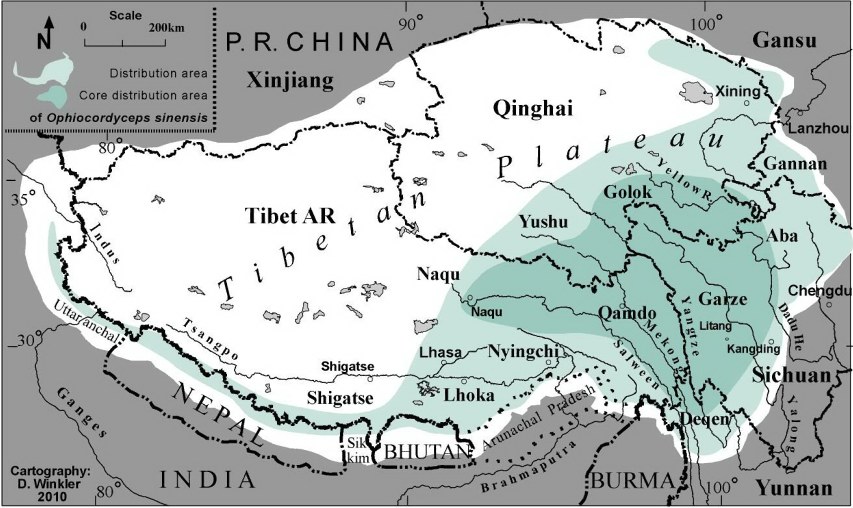 The distribution area of Ophiocordyceps sinensis is lightly green shaded, the core distribution area darker green, in this map of the Tibetan Plateau region. Caterpillar Fungus is distributed in grasslands and shrublands, which receive at least 350 mm average annual precipitation in an altitude of 3000m to 5000m. Locally the occurrence of Cordyceps is within an altitudinal range of 500m around the potential treeline. Cartography: © Daniel Winkler. Published in Winkler, D. 2010. Caterpillar Fungus ( Ophiocordyceps sinensis) on the Tibetan Plateau. In: Geographische Rundschau - International Edition 6.4: 44-49.
Fruiting Stages of Ophiocordyceps sinensis © Daniel Winkler 2010 [from my GRI article, see above]
Yartsa Gunbu Production in Tibet AR and "Global" Production | |
Annual Production of Ophiocordyceps sinensis by TAR Prefecture.  These numbers do not indicate a population crash. O.s. seem surprisingly resilient to incredible collection pressure. | Average Global Annual Production of Ophiocordyceps sinensis in the Tibetan areas of China and the Himalayas. 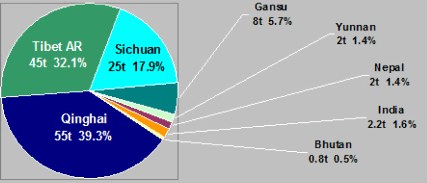 More details in Winkler 2010: O.s. Production and Sustainability Both figures from: © Daniel Winkler. Published in Winkler, D. 2010. Caterpillar Fungus ( Ophiocordyceps sinensis) on the Tibetan Plateau. In: Geographische Rundschau - International Edition 6.4: 44-49. |
 | Tibetan family camping out in the grasslands to collect Yartsa Gunbu. In early spring Tibetans collect this highly prized medicinal fungus since centuries mostly to be traded down to China. However, with market forces pushing their way onto the plateau Yartsa Gunbu hunting is being intensified since the 1980s. It contributes substantially to herders cash income. Snow or sleet showers can occur in subalpine grasslands throughout the year. Even in winter snow rarely remains on the grazing grounds for more than a couple of days due to the intense subtropical insolation. If the snow stays on pastures for several days or longer, it is regarded a snow catastrophe, since livestock will starve due to difficult access to the grass under the snow. © Daniel Winkler Photo: April 2000, 4450m, Litang County, Ganzi TAP, W-Sichuan. © Daniel Winkler |
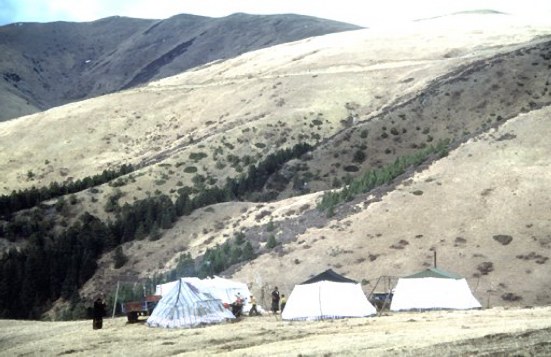 | It's not always snowing at the Junba La. Tibetans camping out in the high pastures to collect Yartsa Gunbu. Several hundred meters up the road this photo has been taken two years later than the previous one. © Daniel Winkler Photo: April 2002, 4450m, Litang County, Ganzi TAP, W-Sichuan. |
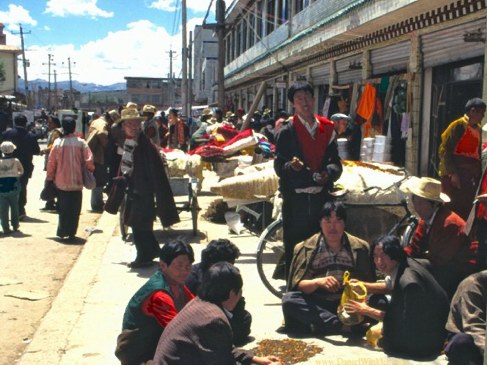 Yartsa Gunbu dealers sitting around freshly bought Ophiocordyceps sinensis on Lithang's main street. During Bu season in May and June this street is buzzing with fungus trade. Khampas from all over Lithang and beyond come to town to sell off their families' collections and stock up on goods. Deals totaling hundred thousands of Yuan (1 US$ = 6.8 Yuan) are made daily in peak season. © Daniel Winkler Photo: May 1999, 4020m, Lithang Town / Litang, Ganzi TAP, W-Sichuan. | 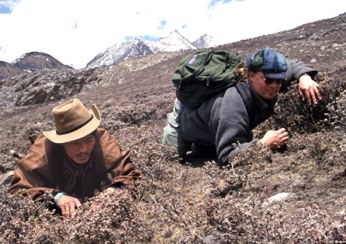 Sonam Doden, a butter, and seasonally "Bu" dealer from Dartsedo / Kangding and myself searching for bu [worm], as Khampas call the Yartsa Gunbu for short near Gye La (Zheduo Shankou) at 4100m. One phrase came to my mind again and again: 'looking for a needle in a haystack'. Actually, the odds of finding the tiny brown stroma, which here grows around Rhododendrons of the Lapponica subsection, seemed stacked against us. In 3 hours, two experienced Tibetan friends and I found 3 specimen. This site was apparently not a prime collection area. Photo taken by Sherab Gyaltsen in Kangding County, Ganzi TAP, Sichuan in April 2004. |
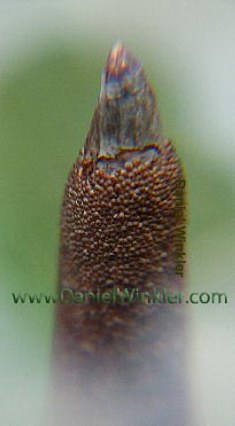 On this mature fruiting body the round perithecia are clearly visible. Inside the perithecium asci cells are growing, in which the spores develop. Cordyceps belongs to the Ascomycetes, the flask fungi. Here a great webpage giving details and illustrations on perithecia in general and Cordyceps gunnii in specific. Kongpo Barla, 4400m, Meldrogongkar County, Tibet AR, June 2006 © Daniel Winkler 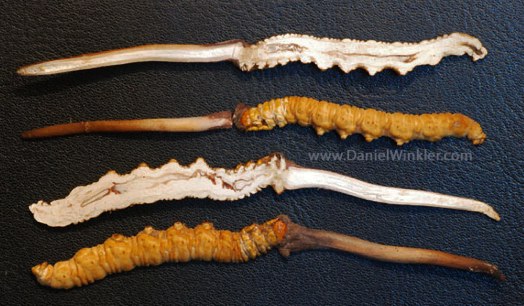 Two Yartsa Gunbu with very initial stromata growth sliced lengthwise to expose the inside. The larvae are completely filled by fungal hyphae, the fungus has replaced most of the former internal organs of the larva. From the host larva only the exoskeleton remains and on the inside the structure of the digestive system. The darker area inside the larva was transformed by the fungus into a sclerotium, think fungal tuber, to better overwinter and readily supply nutrients in spring for stroma growth. 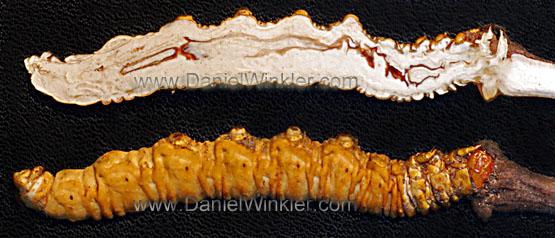 On the outside at the head capsule the red-brown eye segment is visible and its mandibles in the sliced presentation. Right below the head are the three legs of the thorax (on broke off at the lower outside display). At the upper part of the abdomen, which takes up the lower 3/4 of the length of the larva, protrude four prolegs and the anal proleg is located at the end of the abdomen. Specimen from Nagchu, Tibet AR, July 2009 © Daniel Winkler 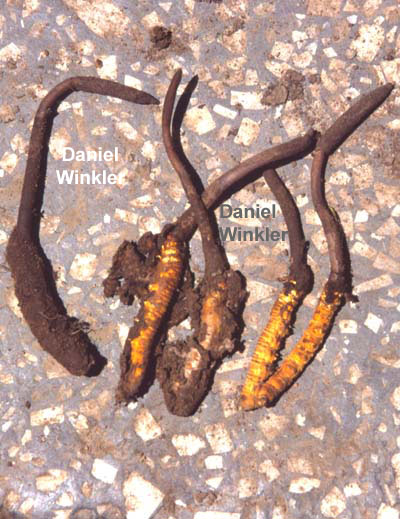 Last change 5-5-2025 | 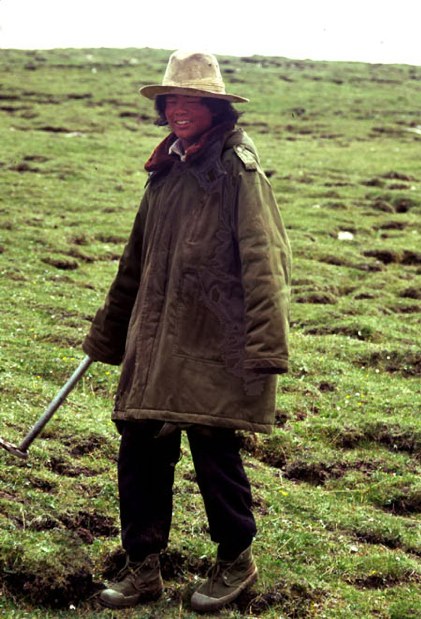 Most county administrations charge collection fees to their residents, most stopped allowing collection by non-residents. The fees for non-residents can be very expensive, ranging from RMB 800- 40,000 per season. Daniel Winkler Photo: June 1997, 4400m, Drachen / Bachen / Baqen County, Nagchu / Naqu Prefecture, TAR 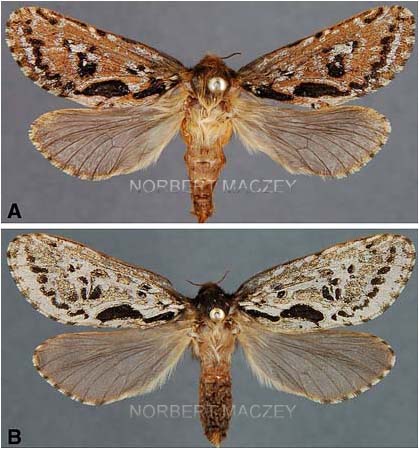 A male (A) and a female (B) ghost moth, Thitarodes namnai Maczey sp. nov., named for Namna pass in Bhutan. Photos generously provided by Norbert Maczey. A great article on the Ophiocordyceps - Thitarodes connection was published by Maczey, Norbert; Kuenzang Dhendup, Paul Cannon, Nigel Hywel-Jones, & Tek Bahadur Rai 2010. Thitarodes namnai sp. nov. and T. caligophilus sp. nov. (Lepidoptera: Hepialidae), hosts of the economically important entomopathogenic fungus Ophiocordyceps sinensis in Bhutan. Zootaxa 2412: 42-52. For the latest research on the moths and the fungus check the excellent research by Wang Zhengyang et al. 2020. The entomophagous caterpillar fungus Ophiocordyceps sinensis is consumed by its lepidopteran host as a plant endophyte. Fungal Ecology 47, 10 p.. |
Selection of my research papers & articles on Yartsa gunbu:
The latest publications:
2017 - The Wild Life of Yartsa Gunbu (Ophiocordyceps sinensis) on the Tibetan Plateau. Fungi 10.1 Spring, p. 53-64.
2013 - Steps towards Sustainable Harvest of Yartsa Gunbu (Caterpillar Fungus, Ophiocordyceps sinensis). Proc.7 Intern. Med. Mushroom Conf. Beijing Aug 2013, p. 635-644. download
2011 – The Year Cordyceps Mushroomed in the Media Landscape but did not thrive in Tibet. Fungi vol: 5.3, 34-39 download
Caterpillar Fungus (Ophiocordyceps sinensis) Production and Sustainability on the Tibetan Plateau and in the Himalayas. In: Asian Medicine 5 (2009) p.291–316. (fake date, published Mai 2011) - Download
Cordyceps sinensis and the Fungal Commodification of the Rural Economy in Tibet - Download So far my most detailed research article on the Caterpillar fungus phenomenon
The Mushrooming Fungi Market in Tibet exemplified by Cordyceps sinensis and Tricholoma matsutake. Download
Cordyceps sinensis - A Precious Parasitic Fungus Infecting Tibet. In: Field Mycology 2010 vol.11.2: 60-67."Download
Infested by the Caterpillar Fungus A once in a lifetime Tibetan experience. 2006. link
Detailed Paper: Yartsa Gunbu - Cordyceps sinensis. Economy, Ecology & Ethno-mycology of a Fungus Endemic to the Tibetan Plateau, 2005.
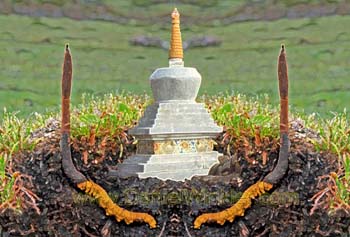
Fooling around with photoshop to make a T-shirt I came up with this design. Feb. 2010 ©
Photo Reports:
2009 Cordyceps Expedition



